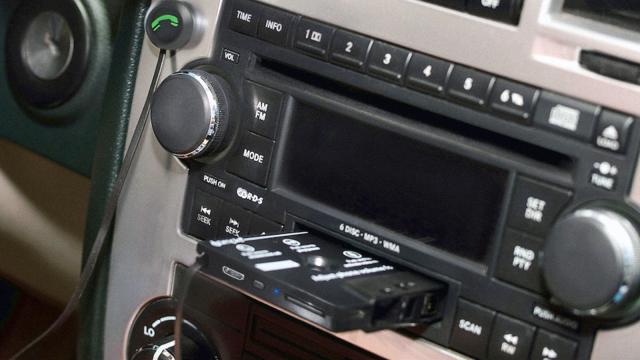Earlier this week we asked you fine bunch about the automotive features you miss that modern cars lack. As I reflected upon my own answer to that question, I realised something: We’ve been sleeping on the cassette auxiliary audio adaptor for years, and it’s high time we make up for that grave transgression.
Sure — chances are you’ve encountered this inexpensive, plastic marvel at some point in the last 20 years. They were a mainstay of so many cars on our roads once upon a time, before auxiliary ports were fitted to OEM head units and surely before Bluetooth was sturdy enough to carry high-bitrate audio.
If you didn’t have one of these guys, perhaps you paid way more for an iTrip — one of those FM transmitters that allowed your iPod to “stream” audio to your car’s radio. They were spotty, sapped battery from your MP3 player and never sounded all that great, even when they worked as intended. If you were on a long road trip, you’d have to keep changing frequencies to find one that wasn’t overridden by a particularly strong signal in a given area.
Not so with the cassette adaptor, one of the most ingenious car-related inventions of the 20th century that truly hit its stride when the iPod became ubiquitous. This simple gizmo repurposed an ancient technology older cars already provided for, so it could be used in tandem with modern methods of storing and playing back music. I’d still probably be using one of these bad boys if I didn’t own a car built in the last 20 years.
But how did they even work? Cassettes house magnetic tape, of course, but these adapters don’t contain tape of any kind. That means the MP3 player, portable CD player or whatever you’re using isn’t writing to a physical medium. So how could it transmit its signal to the cassette deck’s tape head? Why, with a tape head of its own of course! Interesting Engineering explains it well:
Your typical car cassette adaptor works through the use of a single-sided writing tape head. This is similar to the recording head on a traditional tape deck.
Connected to this is, usually, a stereo mini-jack with a cord. This cord is then, in turn, connected to the external audio device’s output (or headphones) port.
Electrical signals are converted into a magnetic signal by the head as a track plays through the connected audio device. This magnetic signal is then received by the car’s tape deck reading head.
Unlike traditional cassette tapes, cassette adaptors lacked a magnetic reel. Magnetic signals were, instead, transmitted directly by a transmitting head positioned where the exposed magnetic tape would normally be.
The cassette deck’s reading head, in turn, converts the magnetic signal into an electrical one (as it would with regular cassette tape) which is then amplified by the sound system.
For a more hands-on demonstration, check the following video courtesy of the wonderful YouTube channel Technology Connections, beginning at the 1:09 mark. (Side note: I first learned about Technology Connections and its host Alec Watson through his unbelievably thorough explanation of how a dishwasher works and why detergent pods suck. I haven’t used detergent pods since, and neither should you.)
Interesting Engineering and Watson both note that most tape decks incorporate an auto-reverse feature designed to be triggered when the supply of tape inside the cassette finishes. That wouldn’t be useful for the purposes of our tape-less adaptor, of course. To defeat this, adapters employ dummy gear mechanisms designed to turn with the deck’s take-up spool indefinitely and only in the forward direction.
Most cassette adapters have a very minor limitation in that they work only when a particular side of the cassette is facing up, because the head within tends to be single-sided. These are extremely cheap products, after all; as Watson tells us, it really is as simple as wiring the other end of the aux cable to the tape head, no circuit necessary.
The resulting audio quality ends up being pretty good and certainly better than you’d expect from a cassette. This is something that regularly blew me away when I was younger and using these things with some regularity, but the reason for that is very simple — the cracks and hisses of cassette playback are the result of imperfections in the tape. Eliminate the tape, and you eliminate the noise it generates.
Most high-end smartphones lack 3.5-millimetre aux ports nowadays — a crime I’m still saddened we were evidently willing to accept as consumers. Newer adapters are capable of picking up a Bluetooth signal; unfortunately, they also contain batteries that must be recharged on their own, ironically complicating the simplicity that made this invention so brilliant in the first place. For those with older cars, Bluetooth is at least better than nothing and definitely preferable to an FM transmitter.
A cassette adaptor’s uses aren’t limited to music either. If you have a strong mic on your phone able to pick up distant voices, or perhaps a Bluetooth mic mounted in your car, it basically transforms your vehicle’s old stereo into a loudspeaker for calls. Ditto for turn-by-turn directions.
Of course touchscreens, CarPlay and Bluetooth are nice and taken for granted at this point, but they’re baked into the car you own. The cassette aux adaptor is clever because it effortlessly modernizes the old car you love and couldn’t stand to part with — all for around $15.
This article has been updated since original publication.
